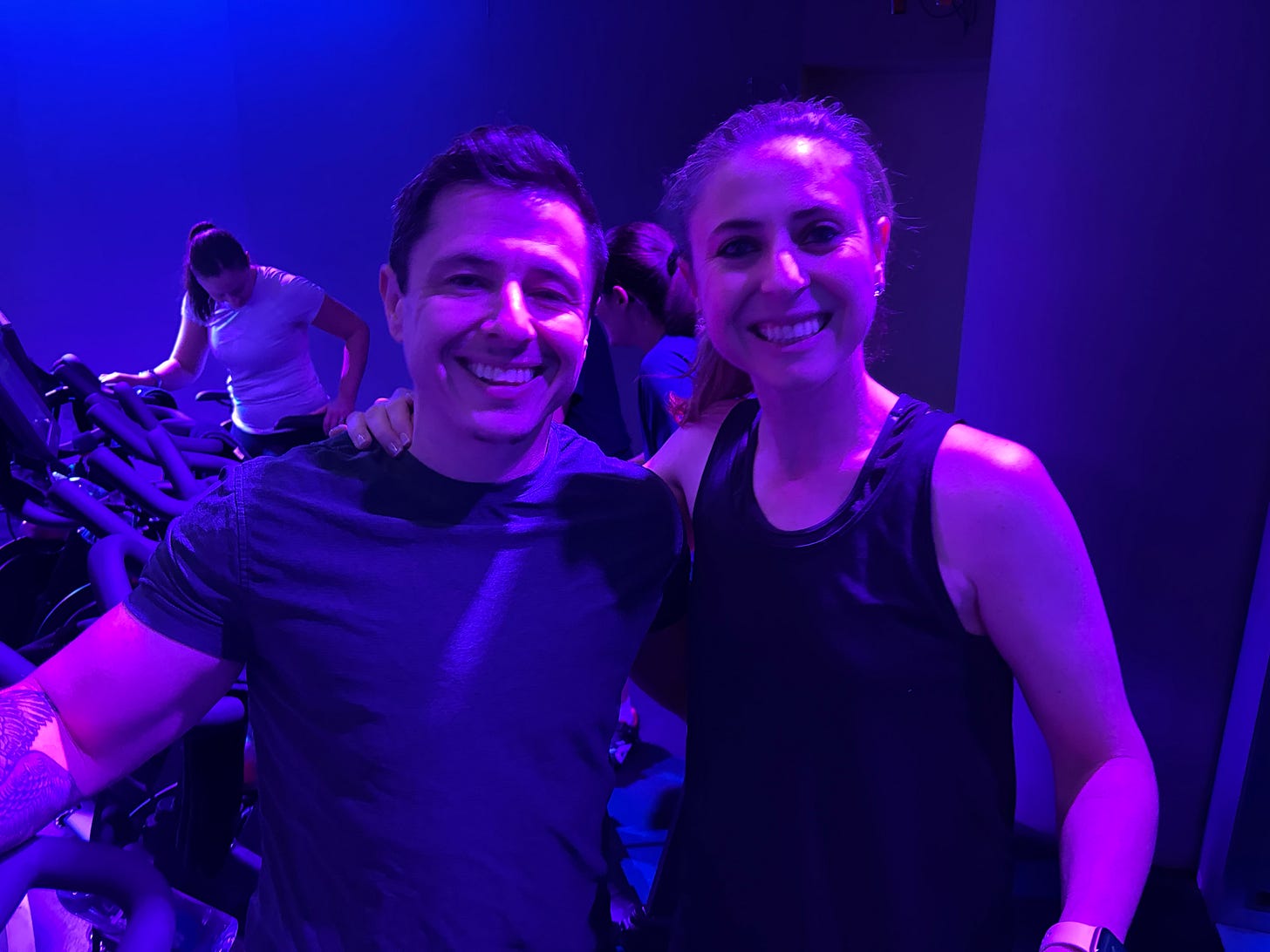The Real Reason You Keep Quitting Fitness Programs
What I learned watching die-hard Peloton fans line up for $40 classes (and I'm one of them)
This past weekend, I was in New York City with my sister, Jessie. She’s 38, I’m 44—both of us are active and into fitness, especially Peloton. So much so, that Jessie stalked the Peloton Studios NYC waitlist until she secured us spots for a live spin class and two strength classes on Saturday.
I’ve been to Peloton Studios a number of times over the years, so the format wasn’t new to me.
But this time, something clicked for me about why these classes work.
My relationship with Peloton
You’ve probably heard of Peloton, but if you haven’t, Peloton makes connected spin bikes, treadmills, even rowing machines. The “fit-tech” company started in 2012 bringing spin class instructors into your living room through a screen. They blew up during COVID when gyms and in-person classes shut down (you might also remember them from the notorious 2019 holiday commercial—the “Peloton Wife” ad).
I was an early adopter in 2015—so early that my username is just my first name (look up “Marek”). Today, they have over 6 million members.
Back then, the classes were grittier and less performative. The instructors hadn’t become celebrities with autobiographies and clothing lines yet. The CEO and COO took classes with everyone else, the instructors knew regulars by first name, and the company got in trouble for streaming music without paying royalties.
I ended up selling my Peloton bike a few years ago, but I come back to the live studios whenever I’m in New York. The energy is different now—more polished, more production value—but despite rising membership and hardware prices, more and more people are showing up.
What keeps people coming back?
The live classes at Peloton Studios are a fantastically good time.
High energy, great music, solid programming, and an overwhelming sense of fitness community completely unique to the in-person experience (similar to the vibe at the starting and finish lines of a marathon).
Plus, you’re part of a live studio audience that millions of members see at home—your workout immortalized for all of digital time. Both the cycling and strength classes buzz with enthusiasm—people fully bought into the Peloton lifestyle.
These aren’t people trying out Peloton for the first time. They are die-hard fans of the instructors and the culture. High fives all around. People lined up outside the class afterward for photos. A cult following for $40 a class.
The energy and enthusiasm in those rooms isn’t just about the workout—it’s about the community, the instructor, the whole immersive experience.
It got me thinking: what actually keeps people coming back to Peloton? To fitness programs in general?
The “it” factor
During these classes, something clicked for me about why some programs work and others don’t. The programs that actually stick do a few things very, very well.
They show you progress early. Not six months from now, but in the first couple of weeks. Something you can see or feel that proves it’s working.
They tell you specifically what’s improving. Not “great job!” but concrete evidence of progress through milestone awards, challenge completion, hitting streaks, etc. It’s not vague encouragement—it’s data you can see improving.
They give you structure that makes it easier to show up. A regular schedule, a routine that doesn’t require you to figure out what to do every time.
Peloton does all three exceptionally well.
The classes, both online and in-studio, are designed so you can track improvement. Then there’s Club Peloton, a points-based reward system to track member progress, dedication, and support (in their words “you’re earning points in recognition of your perseverance and encouragement). Even remotely, the online schedule and community make it easier to just show up.
The real reason people don’t quit
Motivation fades. Recovery takes time. Life gets busy. The stuff that used to work—just do more, try harder, push through—doesn’t always cut it.
When you can’t see whether your work is paying off, you need proof. You need data. You need structure that makes it easier to keep showing up when you’re tired, busy, or doubting yourself.
That’s why people keep showing up to places like Peloton, or join marathon-training groups like Slow AF Run Club, or find a CrossFit gym they never want to leave.
Not because these programs have magic workouts. But because the whole experience is set up to make it easier to stay consistent.
It’s not you, it’s your program
Most programs just give you workouts.
Do these exercises… this many sets… this many reps. Not very inspiring is it?
If you can’t tell whether it’s working, if nobody’s tracking your progress, if there’s no structure keeping you accountable—you’ll quit before it matters.
I talk to people all the time who think they’re bad at sticking with fitness. They think they lack discipline. But really, the program just didn’t give them what they needed to keep going.
If you’re struggling to stay consistent, ask yourself:
Can I see progress in the first few weeks? Not dramatic transformation, but small, real improvements—lifting more, running farther, moving better, feeling stronger?
Does someone (or something) tell me specifically what’s improving? Or am I just guessing whether it’s working?
Is there a structure that makes it easier to show up? A set time, a person expecting me, a routine I don’t have to think about?
If the answer is no, you might just need a better structure—not more willpower.
Where I’m going with this (and what’s in it for you)
This is what I’m building into my training approach now. Programs that show you progress in the first two weeks—not 3-6 months from now. Feedback that’s specific enough to trust, not vague encouragement. Structure that makes it easier to show up without adding complexity.
On Friday, I’ll show you how to evaluate any program—whether it’s the one you’re doing now, something you’re considering buying, or that free program your favorite Instagram trainer posts. You’ll know exactly what to look for and what to do if something’s missing.
Questions, comments, and suggestions?
Thanks for reading,
-Marek





Oooooh loved this!! As somebody who once drove 1 hour (one way) to get to Soul Cycle classes that were $28 each (which was 8 years ago lol) .... I totally resonate with the IT factor. I LOVED those sessions so much. And definitely miss a bit of this spark in my own workouts, to be honest. Looking forward to the next installment!